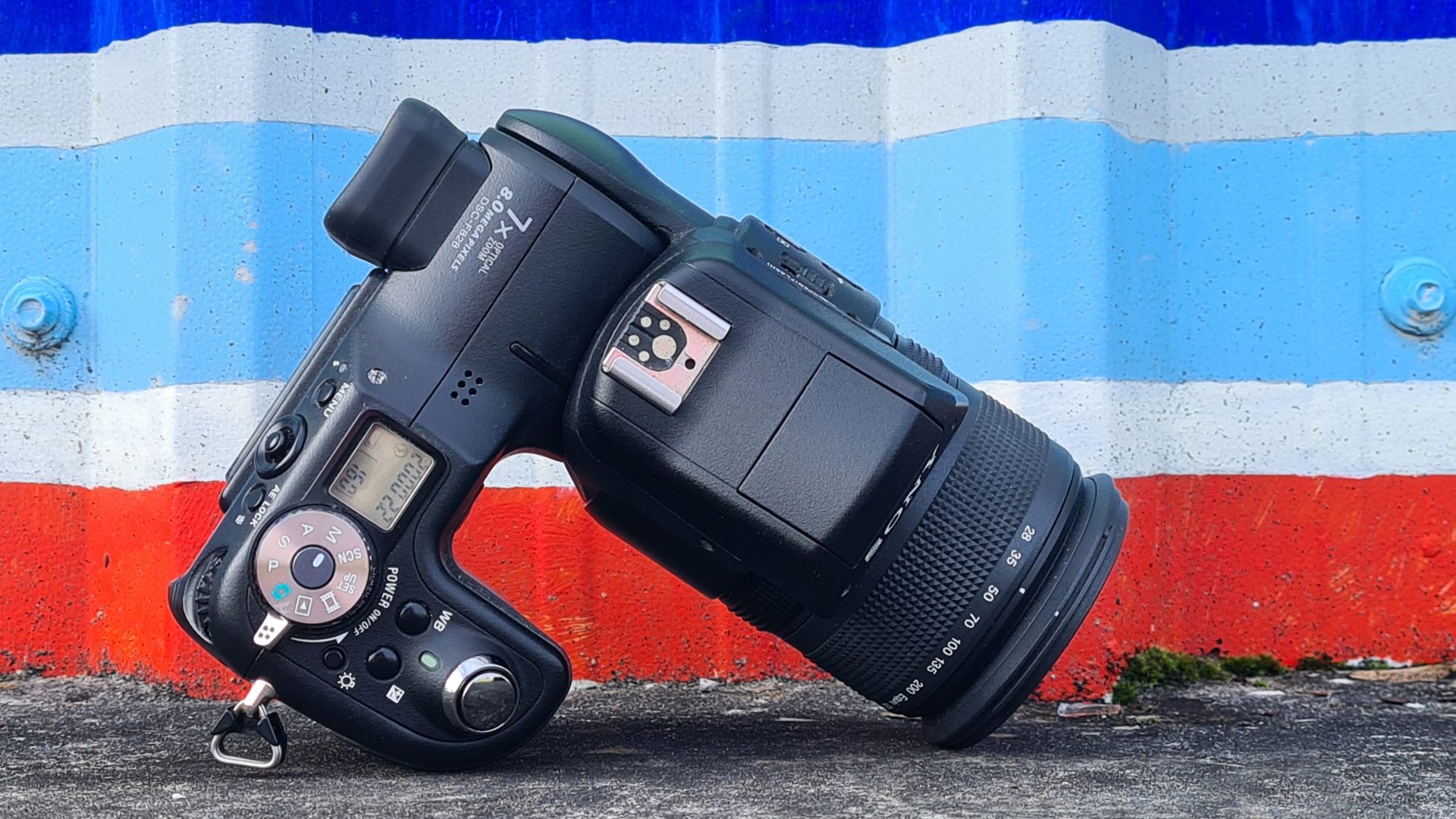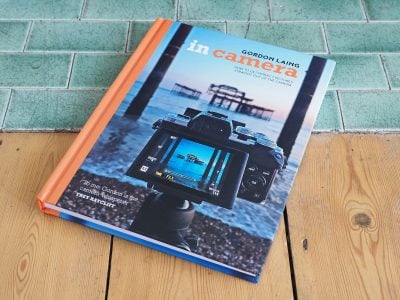Sony Cyber-shot F828 retro review
-
-
Written by Gordon Laing
Welcome back vintage camera lovers for another trip down memory stick lane, and today it’s the turn of Sony’s Cyber-shot F828, a high-end prosumer bridge camera launched in 2003 at a price of around a thousand dollars or pounds.
I reviewed it for both MacUser and PC Advisor magazines when it first came out, and just over two decades later bagged an untested model from eBay for just £43 which sprang into life given a new battery. So join me as I take it for a spin around Brighton 21 years after it was launched, and see why it can still do things most cameras only dream of. Everything is in the video below, but if you prefer to read the written highlights, keep scrolling!
Back in 2003, the F828 built-upon its already gadget-packed predecessors to become Sony’s most feature-filled Cyber-shot to date. It boasted a new 8 Megapixel sensor with a unique colour filter array, a 7x optical zoom with mechanical adjustment, the choice of memory stick or compact flash storage, unlimited VGA video, the chance to shoot in complete darkness, and more buttons than you could imagine, all squeezed into a twisting L-shaped body inspired by the previous F700 and F500 models.
It had also grown substantially in heft, and now wore a black finish, all proving it was really serious, compared those smaller, simpler silver cameras that came before it. And here’s why: in the same year Canon launched the EOS 300D or Digital Rebel, the first sub-$1000 DSLR. Sure it lacked the features of a top-end pro-sumer all-in-one like the F828 and came with a much shorter kit zoom too, but there was no arguing with the considerably larger sensor inside coupled with the chance to swap lenses. DSLRs had long been the ticking time-bomb for bridge cameras, with many photographers just waiting until they became sufficiently affordable before switching to the kind of camera they always wanted. That time had arrived.
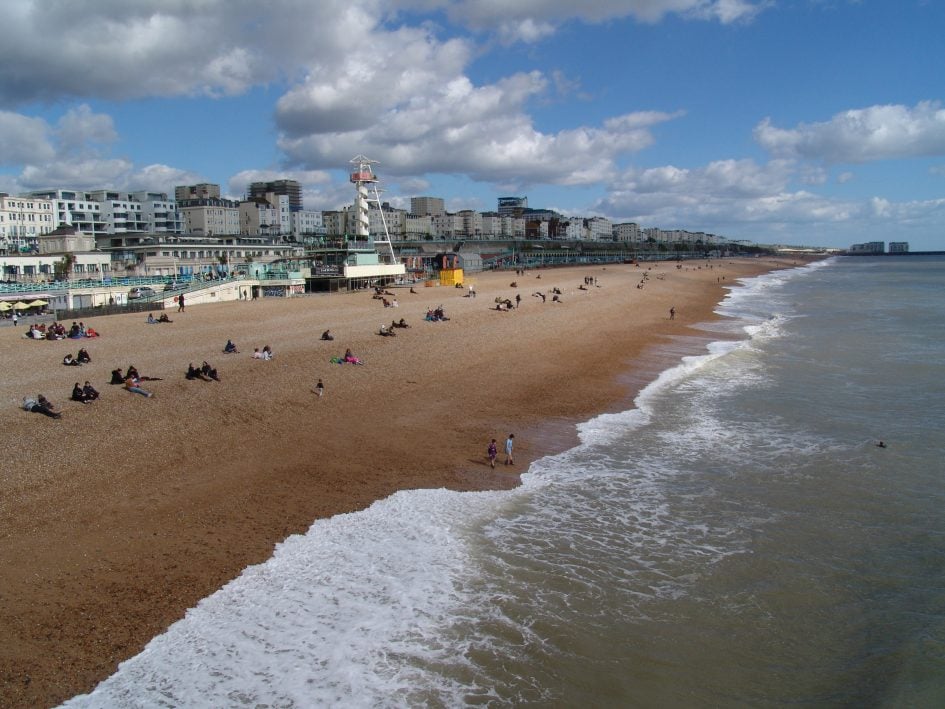
So in many respects the F828, along with other bridge cameras launched alongside it, represented the last stand for this category. Sony, Nikon, Minolta, Olympus and even Canon all launched feature-packed models sporting the same 8 Megapixel sensor around the same time, but all knew they were drinking in the last-chance saloon. But equally they weren’t going out without a fight.
Sony’s F828 was certainly a unique looking camera, clearly inheriting some of the L-shaped design DNA of its predecessors, but bulking-up and presenting a much more serious appearance than the previous F717. Like the models before it, the 828 employed a twisting design where you’d rest the substantial lens barrel in your left hand, leaving your right to angle the body up or down by 70 or 30 degrees respectively for easier framing at low or high angles. At 925g with battery, it was roughly 50% heavier than the previous F717, but that gave it a reassuring heft in your hands. Sony also continued to sensibly position the tripod thread under the main barrel and included a second hole for an alignment pin.
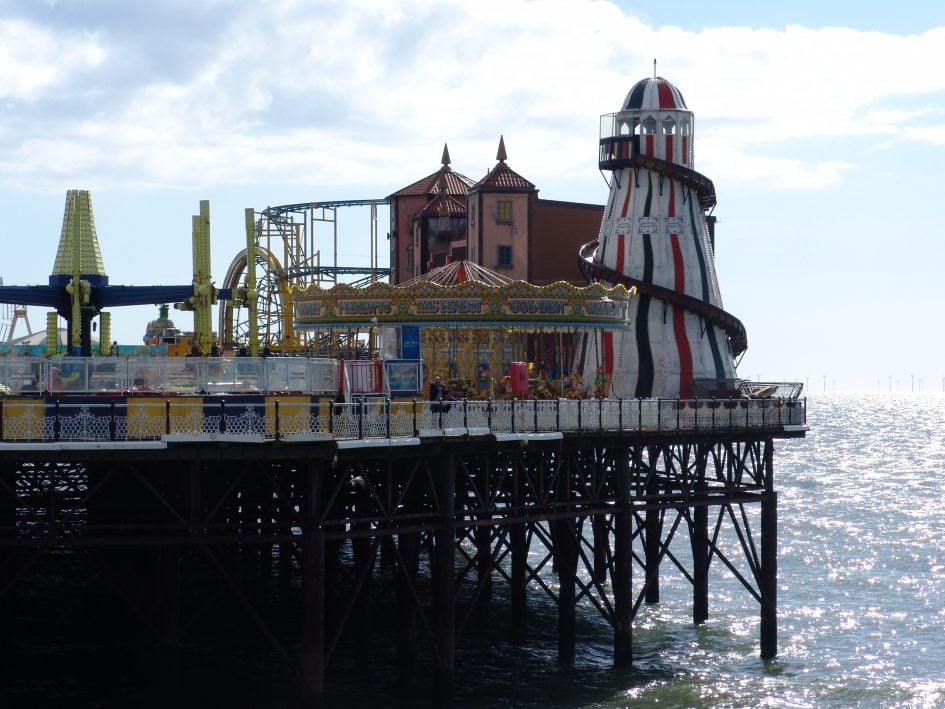
The body hinge was larger than before with a satisfying click when returned to the central position. Unlike the fully-articulated screens on some rivals, it may not have faced-forward for selfies, but in your hands felt more robust and to me remains one of Sony’s design triumphs, especially for waist-level shooting. And remember that budget Canon DSLR screen was firmly fixed in position.
Sony also trumped the range of DSLR kit lenses by equipping the F828 with a new 7x optical zoom, equivalent to 28-200mm, taking you from respectable wide-angle coverage to mid-telephoto. Compare that to the 28-88 equivalent 3x range of a typical 18-55 DSLR kit zoom.
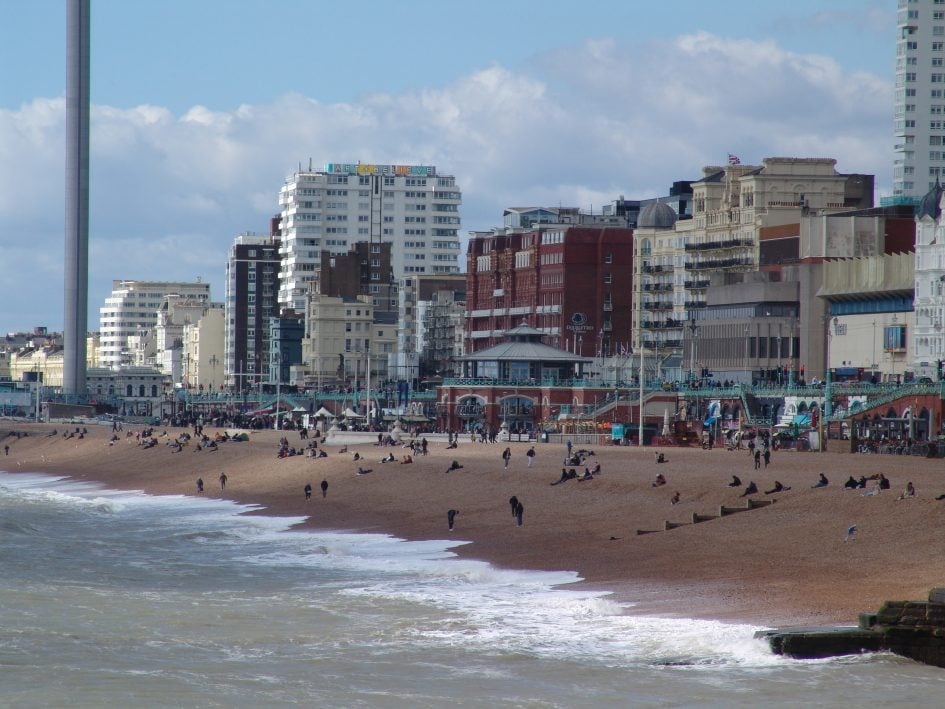
It dipped-in then extended a little as you zoomed from 28 to 200mm, but crucially delivered this range in a barrel about the same size as a 3x DSLR kit zoom. The aperture was also respectably-bright at f2-2.8, allowing for some shallow depth of field effects even if the sensor inside was relatively small.
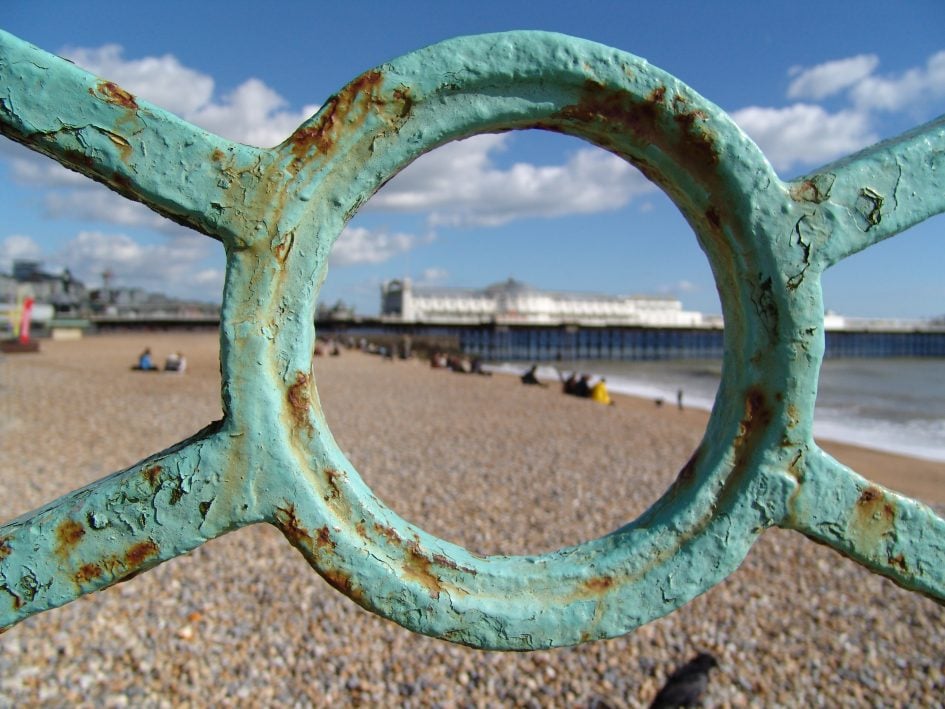
But in turn that small sensor and short actual focal length meant the F828 could also deliver decent macro results, getting as close as 2cm from your subject to capture just 56mm across the frame. That’s way better than a DSLR kit zoom.
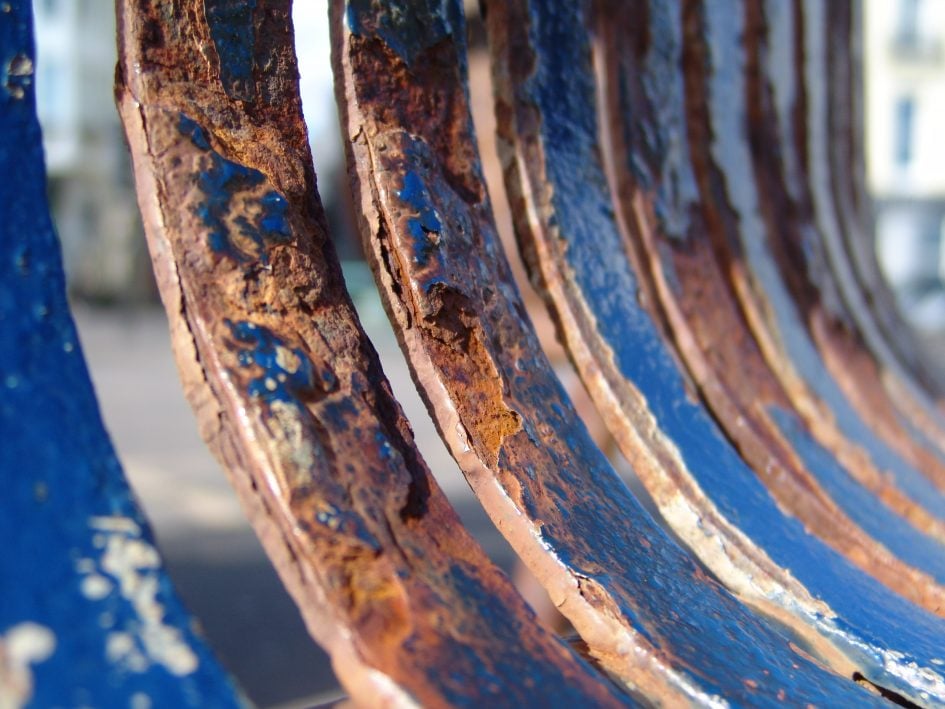
In an important change from its predecessors, not to mention most rivals, the F828 also dumped the motorised zoom control in favour of a mechanically-linked ring. Like a proper DSLR zoom lens, this allowed very precise adjustments over the focal length without the lurching of many electronic systems. For video it may have been harder to maintain a constant zoom speed, but it did allow for dramatic crash-zooms with a sharp twist of the ring.
For composition, the F828 offered a 1.8in screen with 134k pixels, or a 235k dot electronic viewfinder. Eye sensors were a rarity back then, so you’d select between the EVF and screen with a switch. Today the EVF inevitably looks fairly coarse, but 21 years ago it was one of the more detailed around, and could certainly be used for precise manual focusing using the free-spinning ring on the barrel.
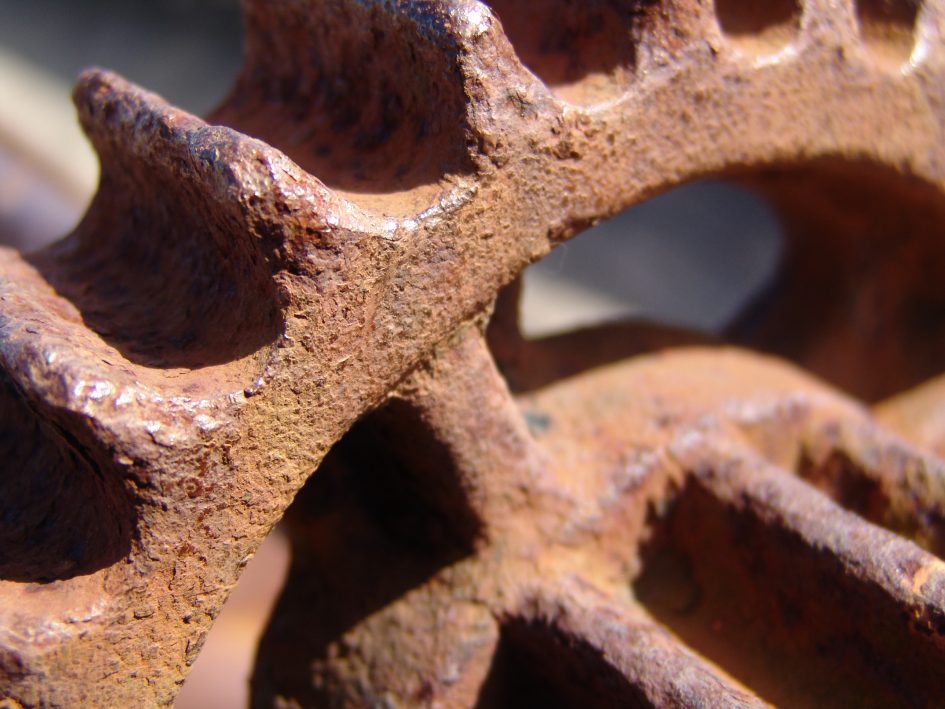
And as an EVF, it also matched what could be done with the screen, with rich multiple information views, a live histogram, menu navigation, and image playback, not to mention more accurate coverage, none of which were possible on a DSLR’s optical viewfinder.
You could tell the F828’s main competition by the substantial exposure mode dial alone, which turned with satisfying clicks and sported a spring-loaded power collar inherited from the F717. The F828 provided full control over exposures including an impressive shutter range of 30 seconds to 1/2000, and apertures from f2 to f8. A faster 1/3200 shutter was also available in Manual mode, but only when coupled with the minimum f8 aperture, as they shared the same mechanism. Alongside the mode dial is a handy LCD information screen with an optional backlight, actually the first top screen on a Cyber-shot F model.
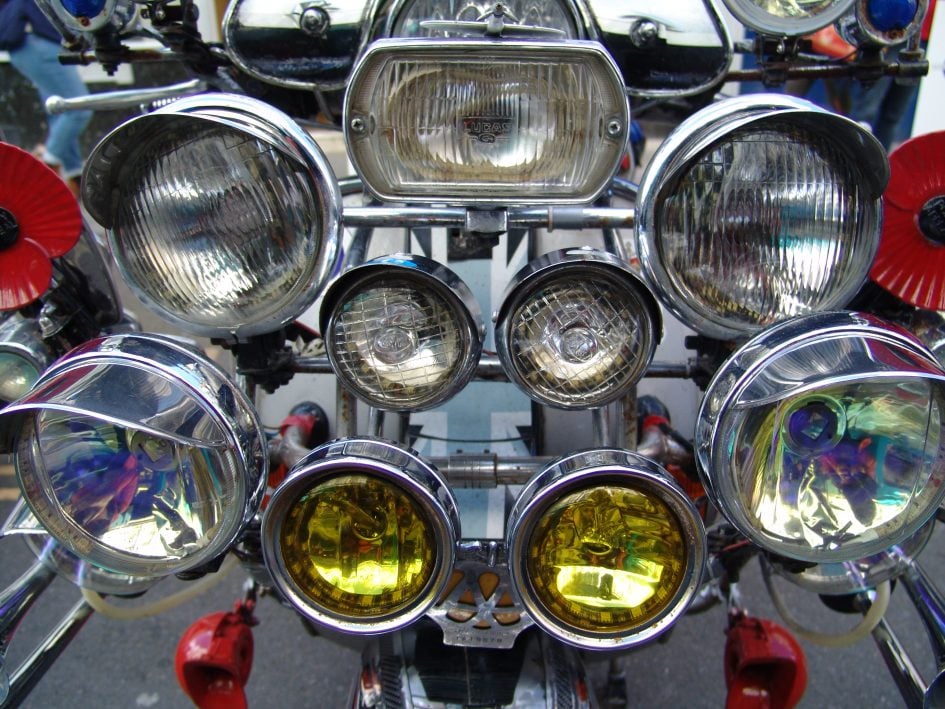
The F828 also had lots of buttons: five on the side of the lens barrel, six around the screen, and three more by the shutter release. Several were dedicated to settings like the flash or drive mode, white balance or exposure compensation and were adjusted by pushing down on them as you turned the rear thumb dial, with a rotating on-screen graphic to confirm. Other settings, along with menus were operated with the rear joystick which I’ll show you in a moment.
The F828 was powered by the same NP-FM50 Info Lithium pack as the 707 and 717 before it, which displays the minutes of power remaining on-screen. This charges in-camera using the supplied AC-L15 power supply. Like most rechargeable batteries from the period, original packs are unlikely to store any charge today, so if you’d like to get the camera working, you should budget for a replacement pack.
I used the same DSTE battery I’d bought for my 707 and 717 reviews which cost about £15, but you will need an original AC-L15 AC adapter to charge it in the camera. Luckily this is also the same as that on the F707 and F717, allowing you to share accessories.

Unsurprisingly as a Sony camera, the F828 could use full-length Memory Stick cards, and by 2003 this also meant compatibility with the latest Pro cards with faster speeds and larger capacities. I used a 2GB Pro Duo card in an adapter which worked fine. Both the Memory Stick and battery are housed in a compartment below the camera.
In a major surprise though, Sony also equipped the F828 with a Compact Flash card compartment on the side of the body, and it would also accommodate thicker Type-II cards including the IBM MicroDrive. A switch by the door open lever lets you choose between CF or MS media.
CF compatibility makes it much easier to use the F828 today, although a standard Mini USB port on the rear allows you to use the camera as a card reader. Do note you will need to be using Memory Stick Pro or an IBM MicroDrive to support the smoothest 30fps video frame rates though; standard CF or MS cards will be limited to 16fps.
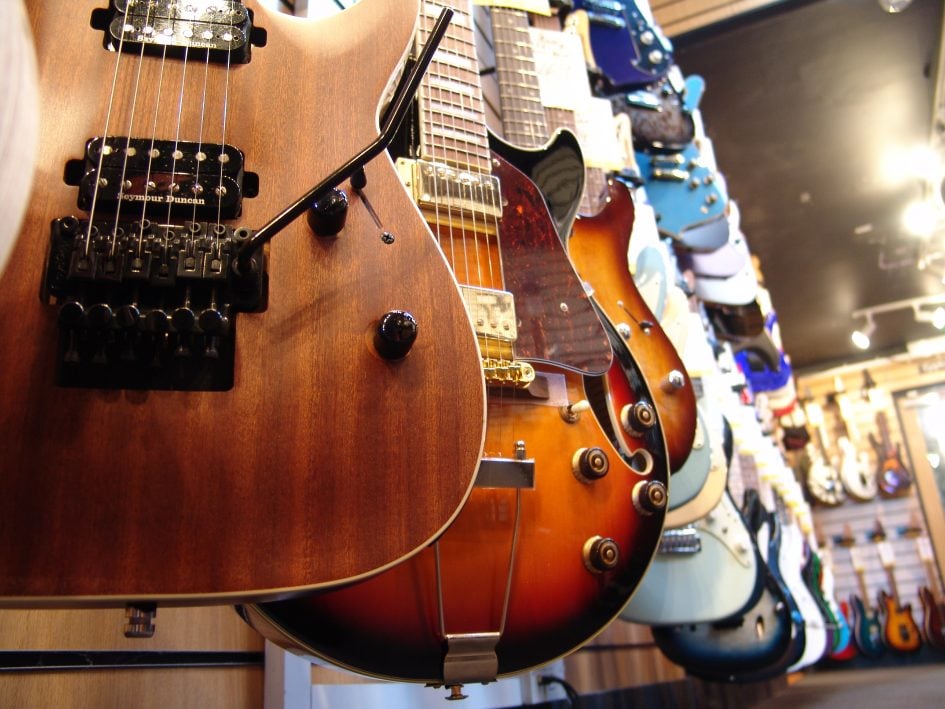
Alongside the USB port on the rear are the charging port and a 3.5mm AV output jack for slideshows on a TV. There’s also a smaller port on the side of the barrel for remote controls or external flash accessories, along with a fully-featured hotshoe. There’s also a popup flash, in turn responsible for the slightly unusually-shaped head.
The F828 became the first camera to exploit Sony’s latest 8 Megapixel CCD sensor, matching the 2/3in type size of the earlier 717, but packing-in considerably more pixels.
Interestingly it also debuted a new colour filter array, switching the traditional red, green, blue, green Bayer pattern, for red, green, blue and emerald, claiming broader and more realistic colours. This also gave the 828 a unique difference from rival models from Canon, Nikon, Olympus and Minolta which may have shared the same core 8 Megapixel Sony sensor, but with more traditional Bayer colour filter arrays. We’ll see in a moment what difference it made in practice.
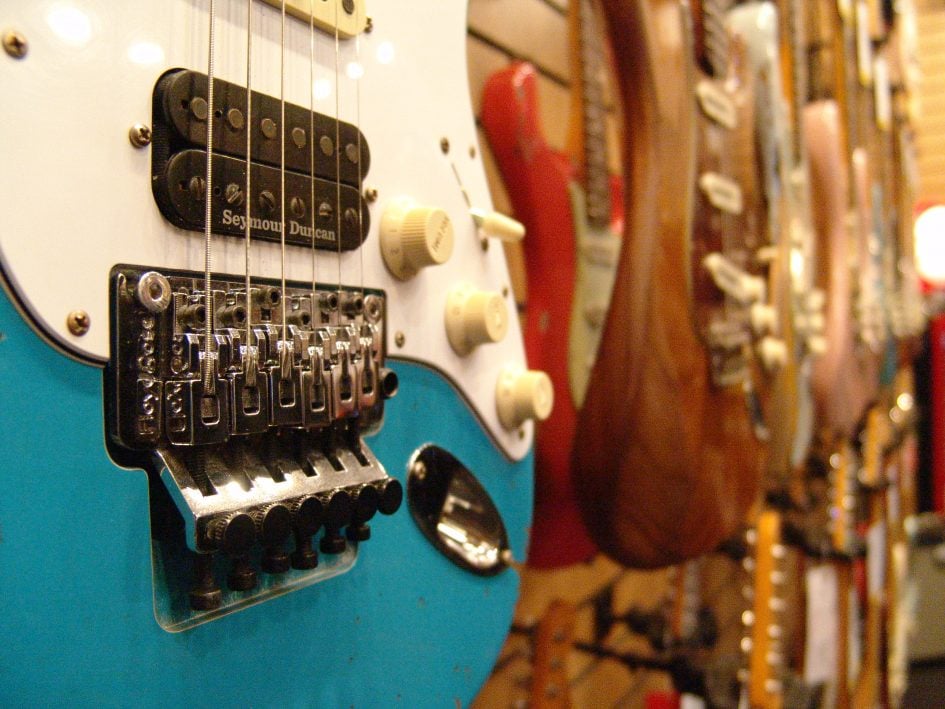
Pushing the menu button popped-up a list of settings, starting with the ISO sensitivity running between 64 and 800 ISO, with an Auto option which in my tests only seemed to select 64 ISO. The lowest values are nice and detailed, but as you approach the higher ISOs, detail is gradually lost to noise and processing. This was where the larger sensor of a DSLR would take the lead, not to mention support higher sensitivities.
Next, there was the image resolution with the maximum 8 Megapixels in the native 4:3 shape, or cropped into a wider 3:2 shape, followed by 5, 3 or 1 Megapixel options all in 4:3. 8 Megapixels doesn’t sound like much today, but it was high at the time, and revealingly more than the 6 Megapixels of Canon’s entry-level DSLR. If you could keep the sensitivity low on the Sony, it could out-resolve the Canon, but again as the ISO increased, a DSLR would have the advantage.
JPEGs were recorded with either Fine or Standard compression, with best quality files measuring around 3.5MB each.
From the next menu you could select alternative formats, including TIFF and making its debut on a Cyber-shot camera, RAW. TIFF and RAW files measured 17 and 24 MB respectively, with both tying up the camera for up to 14 seconds as they’re recorded to your card. RAW also recorded a duplicate JPEG, effectively making it a RAW+JPEG mode.
Next up were three Picture Effects: Negative Art, Sepia or Solarize, but strangely still no monochrome.
The next menu intriguingly offered Standard or Real colour modes, followed by minor adjustments to saturation, contrast and sharpness. But what was that colour mode all about?
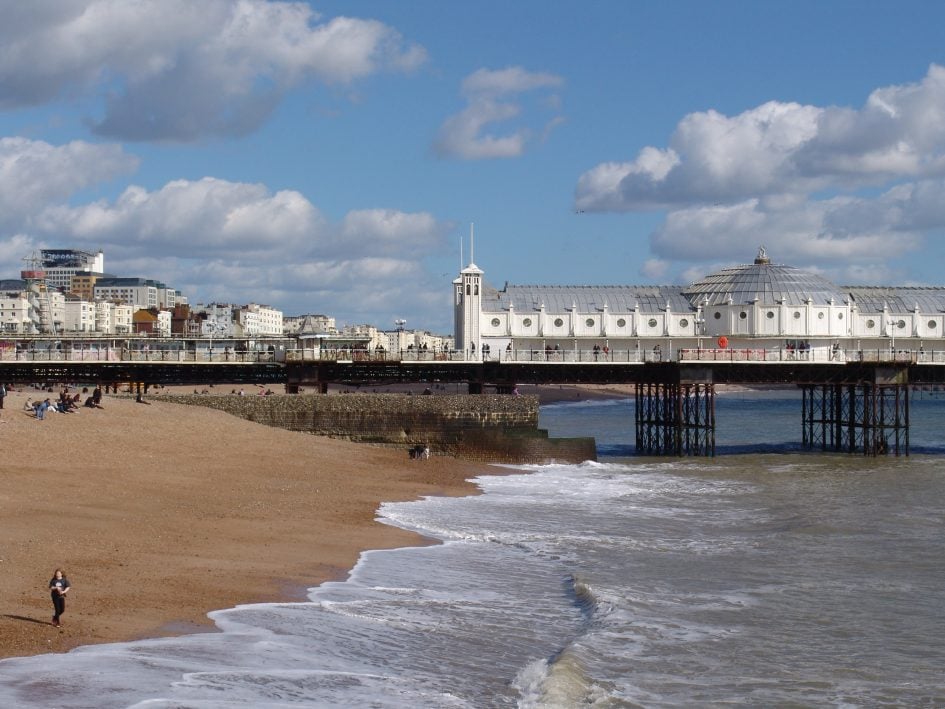
Above: Here’s a shot I took with the F828 in its Standard colour mode. As you’ll also notice on my other photos, it’s quite punchy with fairly bold contrast and saturation.
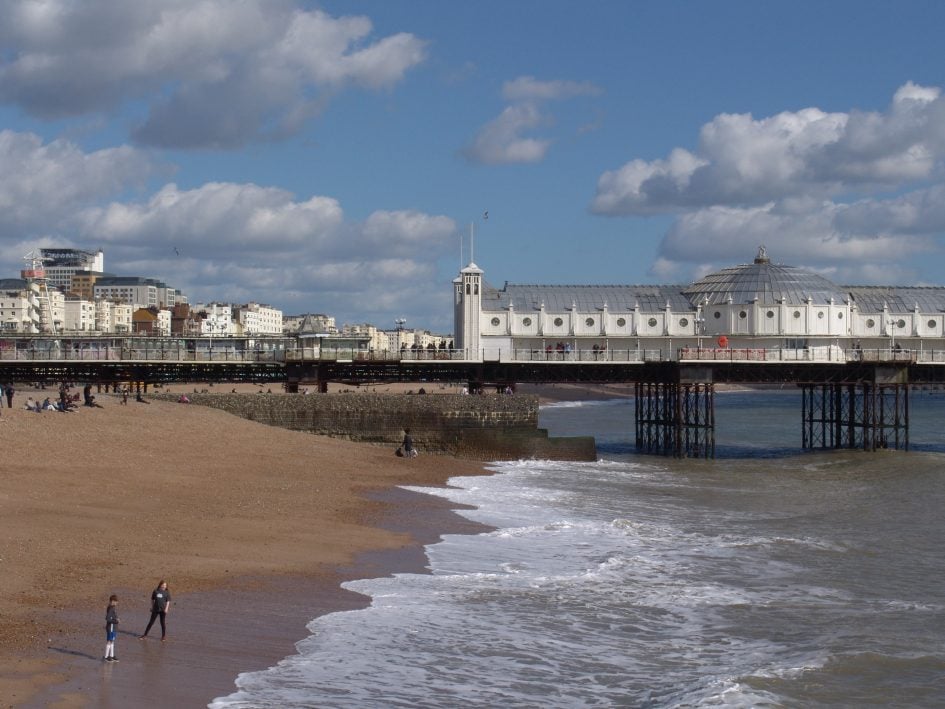
Above: Now here’s one taken with the Real mode, which appears a little more subdued, like the parameters have been toned-down a bit. Sony suggested Real mode was better for subsequent processing on your computer, and I believe used the sYCC colour space versus the more common sRGB.
But regardless, when I look at my photos from the camera, I’m not sure I’m seeing any benefit to its unique colour filter array. In fact if anything, the biggest impact it seemed to have during my tests was to RAW files.
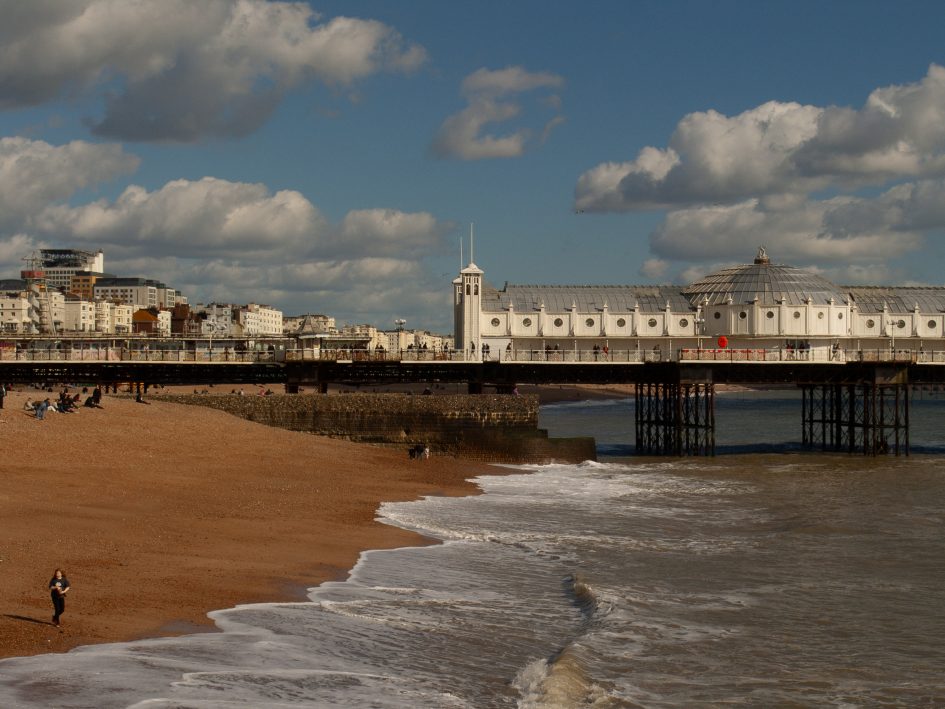
Above: Here’s a RAW file processed without any adjustment in a modern version of Adobe Camera RAW where it suffers from an undesirable tint.
The same thing happens to RAW files recorded in Real colour mode. Certainly Adobe’s software knows what camera it’s dealing with, correctly identifying the SRF file as coming from the Sony F828, but either these RAW files are a bit odd or it doesn’t seem to know how to deal with them.
Maybe it’s the RGBE colour filter array, but if you’re choosing this camera for RAW support, bear in mind you’ll probably need to do some tweaking to get it looking normal first. Alternatively you may have more luck tracking down an old version of Sony’s own Image Data Converter software.
Moving onto video, the F828 could record 640×480 VGA resolution at up to 30fps given a fast enough memory card. Slower cards were limited to 16fps, and there was also a smaller 160×112 option at 8fps. Clips were limited only by memory and included audio, and remember back in 2003, video on a DSLR was still five years away.
I’ll show you some examples in a moment, but first wanted to mention one of the most unique features of the F828: the ability to compose and shoot in complete darkness.
These Night-shot and Night-framing modes were Inherited from the F700 models and a selection of camcorders before them, and all work in a similar way. They exploit the fact most camera sensors can also record infra red light, but they filter it out for general use.
Sony’s night modes temporarily removed this blocking filter to allow the sensor to see both visible and infra red light, then simply shone infra red LEDs like torches to illuminate a nearby subject without ever being visible to our eyes. Sony then added a green tint to make them look like military night vision, and bingo, you could live-out your eerie Ghostbusting fantasy in the dark.
The feature earned some notoriety on early models with stories of seeing through clothes, something I never experienced, but Sony did gradually hobble its flexibility and phase it out with the F828 being the last model to have it.
But the chance to switch a camera between visible light and full spectrum without permanently modifying it is an intriguing capability, especially when it was discovered you could move the blocking filter by placing a powerful magnet near the camera. This would bypass the Nightshot mode with its auto settings, high sensitivity and green tint, and just let you shoot full-spectrum in all the normal modes using the best quality settings. Then when you were done, just turn the camera off and on again to go back to normal photos.
This so-called magnet hack appeared to work on the F707 and F717, but sadly neither camera could subsequently focus on distant landscapes once the blocking filter had moved. However I can confirm the F828 will focus on distant subjects after the magnet hack, and at any focal length on the zoom too.
To make it work, take a strong magnet and place it near to the accessory port on the underside of the lens barrel. You may need to try both sides of the magnet and move it around a little to find the right spot. Once you hit the jackpot, you’ll hear the click of the blocking filter being moved-aside and be greeted by a red-tinted full-spectrum image.
If you prefer pure infra-red photography, simply screw on an IR filter that blocks visible light; I used a Hoya R72 Infra Red filter in the 58mm size. The colours look strange, but converting them to black and white can be very effective.

Above: Infra red photos can look great with green foliage which glows brighter than normal. So here’s another view, first in visible light.

Above: next in full-spectrum using the magnet hack.
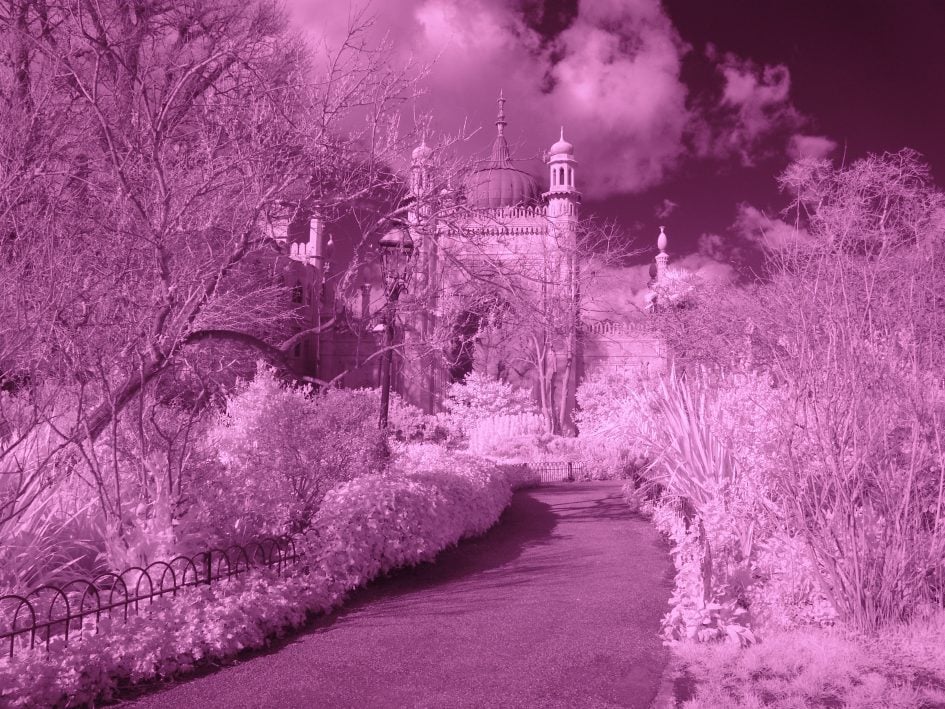
Above: next in infra-red light only.
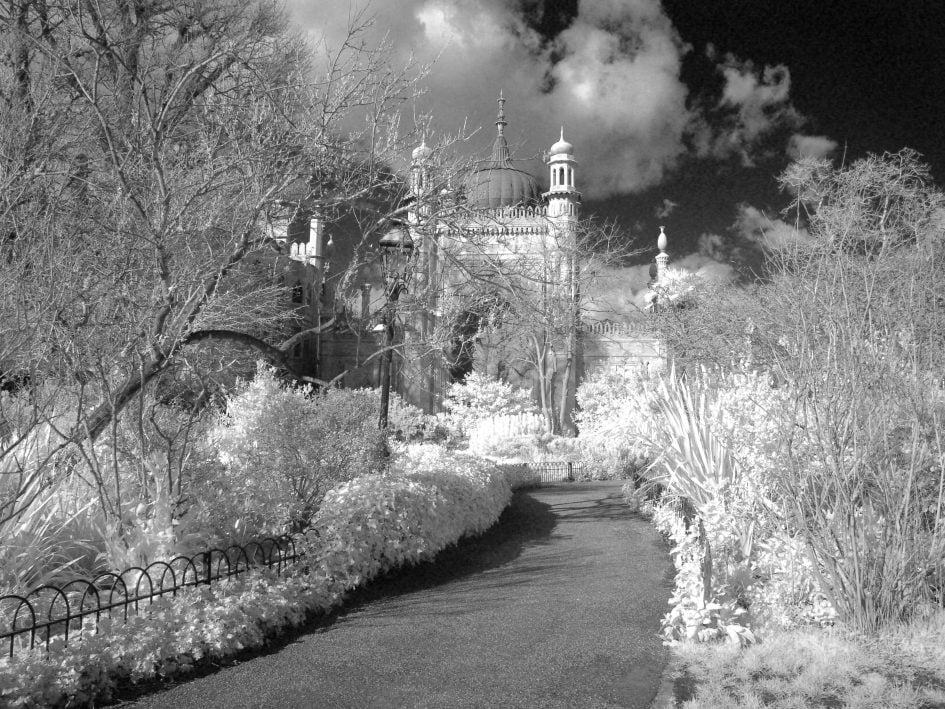
Above: now with that version converted to black and white with a contrast boost. Notice how the greenery looks white here, almost like snow, but this was taken on a warm Spring day.
Once again the magnet hack allows the F828 to take full-spectrum images or infra-red with a filter in any mode, at the base sensitivity for the best quality, with full control over exposure, and the chance to shoot in RAW if you like.
You can even film videos in full-spectrum or filtered infra-red light for special effects, perhaps to recreate those Harkonnen Gladiator scenes in Dune Part 2, or maybe just keep it in a nice park.
Sony Cyber-shot F828 final thoughts
The F828 represented the pinnacle of Sony’s innovative Cyber-shot F series, the fifth and what would become the final model in a series that started with the F505 back in 1999. Four years of evolution saw the cunning L-shaped design with its twisting body steadily grow in size, gain a viewfinder, increase its resolution, and even shoot in the dark.
The F828 may have suffered from more purple fringing and electronic noise that I’d have liked, but the pros far out-weighed the cons. This was an overwhelmingly feature-packed camera with a space-age look, but the elephant in the room was Canon’s first sub-$1000 DSLR.
Sure, the EOS 300D or Digital Rebel was primitive in features, but for the same money you were getting a considerably larger sensor and the chance to swap lenses, and even use your old ones. Even if the 300D or Rebel wasn’t quite there yet for many of us, the writing was on the wall for prosumer bridge cameras like the Cyber-shot F series.
In the following years, super-zoom cameras took over what remained of a decreasing prosumer market, although there were occasional harks back to a more classic period. Sony’s Cyber-shot R1 for example is arguably a reimagined F828 with an APSC sensor.
But while the demise of prosumer cameras was an inevitable timebomb waiting for DSLRs to become affordable, they co-existed for long enough for what was initially considered second-best to become more compelling in some respects. Just compare the F828 against the Canon DSLR kit: for the same money, the Sony gave you a much longer zoom range, a twisting body for easier composition, and the chance to record video or shoot in darkness. And it looked way cooler too.
But what really makes the F828 attractive two decades later was the discovery of how easily it could become a full-spectrum or infra-red camera without permanent modifications. This was never an intentional feature, but it works so well you wish it were possible on modern cameras, albeit trickier due to their larger sensors and corresponding filters.
This is why I celebrate the F828 as one of the best vintage digital cameras out there. Some may see it as a failure due to it being the last of its kind, not to mention the first and only model to use that RGBE filter, but the irony is it’s actually become one of the most attractive models of the period. Snap one up while you can.
Check prices at Amazon, B&H, Adorama, eBay or Wex. Alternatively get yourself a copy of my In Camera book, an official Cameralabs T-shirt or mug, or treat me to a coffee! Thanks!